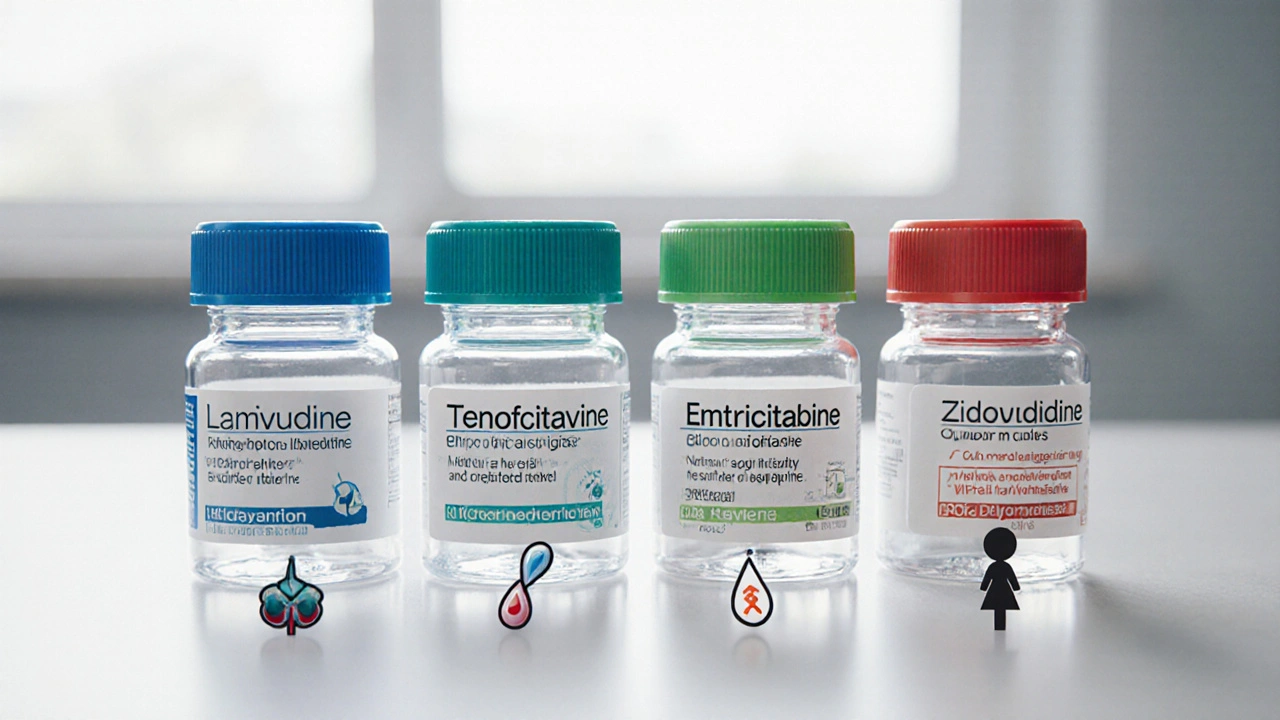Antiretroviral Selection Tool
This tool helps determine the most appropriate antiretroviral medication based on your health factors and preferences.
Quick Takeaways
- Lamivudine (Epivir) is a low‑dose, well‑tolerated NRTI used for HIV and chronic hepatitisB.
- Tenofovir and Emtricitabine share a similar potency but differ in kidney safety and once‑daily dosing.
- Zidovudine is older, has more blood‑related side effects, and is rarely first‑line today.
- Cost, resistance profile, and pregnancy safety are the main factors that tip the balance.
- Talk to a clinician about your liver, kidney and viral‑load status before switching.
When a doctor prescribes Lamivudine (Epivir), the hope is to keep the virus in check while causing few side effects. But the market is crowded with other nucleoside reverse‑transcriptase inhibitors (NRTIs) and newer agents. This guide breaks down how Lamivudine stacks up against the most common alternatives, so you can see where it shines and where it falls short.
What is Lamivudine (Epivir)?
Lamivudine is a synthetic nucleoside analogue that blocks the reverse‑transcriptase enzyme used by both HIV and hepatitisB virus (HBV). Approved in 1995, the pill is usually 150mg once or twice a day and can be combined with many other antiretrovirals. Its main selling point is a mild side‑effect profile and a modest cost in most pharmacies.
How Lamivudine Works
Lamivudine inhibits the reverse transcriptase enzyme, preventing the viral RNA from turning into DNA - the first step needed for the virus to insert itself into host cells. Because it mimics the natural building block cytidine, the viral polymerase incorporates it and then stalls, halting replication. This mechanism is shared by other NRTIs, but the exact chemical shape gives Lamivudine a slightly lower binding affinity than newer agents like tenofovir.

Key Alternatives at a Glance
Below are the three most frequently mentioned alternatives, each with its own strengths.
- Tenofovir disoproxil fumarate (TDF) - a powerful NRTI praised for high barrier to resistance and once‑daily dosing, but can affect kidney function.
- Emtricitabine (FTC) - chemically close to Lamivudine, often paired with tenofovir in popular combos like Truvada; tolerability is excellent.
- Zidovudine (AZT) - the first NRTI approved for HIV; still useful in some regimens but linked to anemia and neutropenia.
Side‑Effect Snapshot
All antiretrovirals can cause trouble, but the likelihood differs.
| Drug | Headache / Nausea | Kidney impact | Blood/hematology | Pregnancy safety |
|---|---|---|---|---|
| Lamivudine | Rare | None | None | CategoryC (considered safe) |
| Tenofovir (TDF) | Occasional | Potential loss of eGFR | None | CategoryB (generally safe) |
| Emtricitabine | Rare | None | None | CategoryB |
| Zidovudine | Common | None | Anemia, neutropenia | CategoryC |
Decision Criteria to Weigh
- Efficacy against HIV/HBV - All four drugs suppress viral load, but tenofovir shows the fastest decline in HIV RNA.
- Resistance barrier - Lamivudine and emtricitabine share similar low‑level resistance mutations (M184V/I). Tenofovir’s high barrier makes it a go‑to when resistance is a concern.
- Kidney health - If you have chronic kidney disease, lamivudine or emtricitabine are safer bets than tenofovir.
- Convenience - Once‑daily dosing (tenofovir, emtricitabine) beats twice‑daily lamivudine for busy lives.
- Cost and insurance coverage - Generic lamivudine often costs less per month than brand‑name tenofovir combos.
- Pregnancy considerations - Lamivudine and emtricitabine have long track records in pregnancy; zidovudine is also used but with more monitoring.
When Lamivudine Is the Right Choice
If you have mild to moderate HIV or chronic HBV, normal kidney function, and you’re looking for an affordable, twice‑daily pill with minimal side effects, lamivudine fits the bill. It’s also the preferred NRTI for many pregnant patients because the data pool spans decades.
When an Alternative Might Suit You Better
Consider tenofovir if you need a high‑potency, once‑daily regimen and your kidneys are healthy. Emtricitabine is a natural partner to tenofovir, giving you the convenience of a single‑tablet regimen (e.g., Truvada). Zidovudine could still be useful in resource‑limited settings where newer drugs aren’t available, but be ready for regular blood‑work to catch anemia early.
Practical Tips & Common Pitfalls
- Never stop lamivudine abruptly; viral rebound can happen within weeks.
- If you’re switching from zidovudine to lamivudine, check your hemoglobin first - you’ll likely see improvement.
- When adding tenofovir, monitor kidney labs (serum creatinine, eGFR) every three months.
- Talk to your pharmacist about generic versus brand options; price differences can be significant.
- Keep a medication diary. Even mild side effects like nausea can be managed better when you track them.
Frequently Asked Questions
Can I take lamivudine with tenofovir?
Yes. The combination is common in fixed‑dose tablets (e.g., Truvada) and provides a strong barrier to resistance. Your doctor will adjust the dose based on kidney function.
Is lamivudine safe during pregnancy?
Lamivudine is classified as CategoryC but has been used safely in thousands of pregnancies. It helps keep the mother’s viral load low, reducing the risk of mother‑to‑child transmission.
What’s the main resistance mutation for lamivudine?
The M184V/I mutation in the HIV reverse‑transcriptase gene reduces lamivudine’s effectiveness but also makes the virus less fit, which can be a strategic advantage in some regimens.
How does the cost of lamivudine compare to tenofovir?
Generic lamivudine often costs 30‑40% less per month than brand‑name tenofovir combinations, though price varies by pharmacy and insurance coverage.
Do I need regular blood tests while on lamivudine?
Routine monitoring of liver enzymes and viral load is standard, but lamivudine rarely causes blood‑cell abnormalities, so extra hematology labs aren’t usually required.


Comments (12)
abhishek agarwal
Lamivudine is a solid go‑to when you need a low‑cost NRTI with a clean side‑effect profile. It works well for both HIV and HBV, and the twice‑daily dosing isn’t a huge burden for most patients. If kidney function is okay, it’s hard to beat the price‑to‑efficacy ratio.
Michael J Ryan
Really helpful tool! I love how it walks you through kidney function, pregnancy status, and even cost concerns in plain language. The visual layout makes picking the right regimen feel less intimidating.
Khalil BB
Lamivudine’s resistance barrier is modest, but the M184V mutation actually weakens the virus. That paradox can be leveraged in some combination strategies.
Keri Shrable
Lamivudine is cheap 💸 and easy on the stomach 😌 it’s perfect for folks who want a gentle pill 👍
tim jeurissen
The article correctly states that lamivudine has a negligible impact on renal function; however, it overlooks the fact that tenofovir’s nephrotoxic potential is dose‑dependent. Moreover, the claim that “lamivudine is the cheapest option” requires citation, as generic pricing varies regionally. Readers should be aware that cost‑effectiveness analyses must incorporate insurance formularies.
lorna Rickwood
if we think about medicine as a river the flow of choices mirrors the current of life we must not forget that each decision ripples downstream influencing outcomes
Amit Kumar
Great breakdown! 🙌 I’ve been juggling between lamivudine and tenofovir for a while and this really clarifies when each shines. 👍💊
Sonia Michelle
The nuance lies in the patient's renal profile; when eGFR drops below 30 mL/min, lamivudine's lack of renal clearance becomes a decisive advantage. In such cases, the modest potency is outweighed by safety.
Neil Collette
Oh sure, because everyone loves reading a 20‑page dissertation on why cheap pills are revolutionary.
Bryan Kopp
Honestly I just take what the doctor gives me, no need to overthink the pharmacology.
Brenda Hampton
Anyone else notice how the cost‑sensitivity section could include pharmacy discount programs? It might help patients on tighter budgets.
Lara A.
Indeed; the pharmaceutical industry-whoever-deliberately hides the true price!! They want us to believe generic lamivudine is always cheap; but hidden rebates and tiered pricing make the reality far more complex!!!